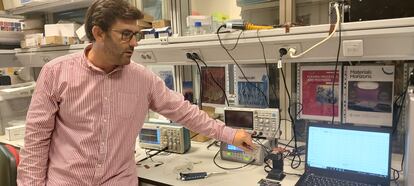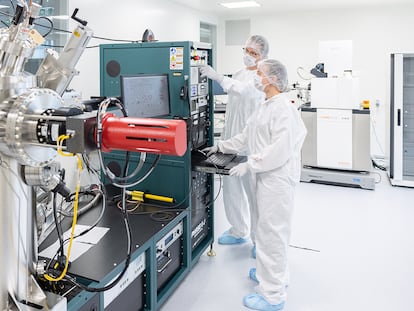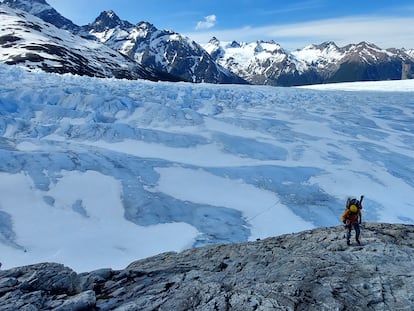Lessons from nature to harvest energy
Two recent scientific studies have been inspired by the lotus flower and scavengers. They are part of an attempt to develop surfaces and devices that take advantage of residual power

Nature and certain social behaviors provide solutions that science takes time to interpret and imitate. The lotus flower, for instance, is a work of natural engineering that has created a unique surface — one that repels the water wherever it lives. And scavenger animals are the great recyclers of the environment (like the people who collect what has been discarded or abandoned).
Both of the aforementioned examples have inspired two scientific projects, led by the Spanish National Research Council (CSIC) and the University of Seville. They’ve developed hydrophobic materials (materials that repel water) to prevent the formation of ice. They’ve also put together a system capable of taking advantage of the residual energy generated in activities from daily life.
The first of the research investigations, called Sound of Ice, is a project that has developed an energy-efficient, environmentally safe and autonomously-operated defrosting system. It’s based on acoustic transducers: devices that transform the effect that a physical cause has on another type of signal.
The first step in developing this system was to create a surface that would reduce icing, a natural process that can ruin the effectiveness of drones, wind turbine blades and, on a larger scale, affect the aerodynamic behavior of airplanes. “One of the strategies used to generate ice-resistant, hydrophobic surfaces is to copy what nature has optimized for so many years,” explains Ana Borrás, a CSIC scientist who is part of both projects. “The surface of the lotus flower,” she adds, “is one of the references. It has a roughness on various scales, with protuberances — visible under a microscope — that generate spaces where air remains. The surfaces we’ve developed aren’t only very difficult to get wet: they also allow water droplets to move freely.”
Starting from this “passive surface” that reduces and delays the formation of ice, the second step has been, as Borrás explains, “to integrate a device [into surfaces] that allows for the detection of ice generated and applies energy through acoustic waves.”
Ángel Barranco, a CSIC researcher and the leader of a nanotechnology group that’s partnered with University of Seville, highlights the importance of inspiration in the lotus flower: “The multi-level structure can be manufactured in the laboratory, but the idea wouldn’t have been [conceived so precisely] if it hadn’t been seen working in nature.”
For Borrás, the large-scale reproduction of the surface developed in the laboratory is now possible. The associated smart device has already been tested in small dimensions (in six by six inch formats), but the researchers believe that it will be possible to scale it. It’s already able to prevent ice from affecting surveillance drone lenses, although the ultimate objective is to avoid the natural formation of ice in antennas, wind turbine blades, or airplane wings.
Energy seekers
The second of the projects, 3DScavengers, has seen the researchers develop devices capable of capturing the energy that is released in everyday actions, such as turning on a light, or the random movement of people. “The idea,” Borrás explains, “is to take advantage of the environmental microenergy, the one you have around you in the form of heat or vibrations, or even [what comes] from the lighting you have on in a room.”
Scavenging has also influenced the development of devices based on nanotechnology that allow light, temperature changes, and mechanical vibrations or deformations — which aren’t constant and homogeneous to be converted into a usable and cumulative energy source.
Barranco explains that this could be the power source for sensors in buildings or farms, which capture the energy available in the environment. “There are many initiatives like these, with energy sources such as thermal — very common in a friction process — or electromagnetic radiation. If you measure the electric field in a street with Wi-Fi signals, it’s a source of energy that a cell phone uses to send signals… but most of it is projected in large areas and ends up dissipating,” he comments. These remnants could be captured and used.
“Energy can be extracted from the human body, temperature, movements and vibrations. Ultrasounds used for [the purposes of] medical diagnosis can also be used to introduce energy into a device inside the body. The best-known ones are meant to regulate the heart, but they can also activate nerves and perform many functions.” This has also been tested with air currents from fans.
The idea, as Barroso explains, is that all the energy generated can be used to power devices. “A small solar cell on your shoulder throughout the day can accumulate enough energy to recharge your cell phone. In a manufacturing line, 30% of the energy injected is consumed in vibrations.”
Furthermore, according to Barroso, “there’s no limitation to the improvement in the energy consumption of devices. In the future, they’ll need much less [energy]... and it’s possible that this environmental energy will be enough to serve as a power source.”
He provides an example: “Thousands of sensors on a bridge provide local information about each point and precisely detect where a problem arises, without depending on a single wired sensor connected to the internet.”
The 3DScavengers project even aims to take advantage of the movement of water when it falls through storm drains, or convert the impact of raindrops into electrical current. This would have applications on surfaces such as windows or solar panels.
Sign up for our weekly newsletter to get more English-language news coverage from EL PAÍS USA Edition
Tu suscripción se está usando en otro dispositivo
¿Quieres añadir otro usuario a tu suscripción?
Si continúas leyendo en este dispositivo, no se podrá leer en el otro.
FlechaTu suscripción se está usando en otro dispositivo y solo puedes acceder a EL PAÍS desde un dispositivo a la vez.
Si quieres compartir tu cuenta, cambia tu suscripción a la modalidad Premium, así podrás añadir otro usuario. Cada uno accederá con su propia cuenta de email, lo que os permitirá personalizar vuestra experiencia en EL PAÍS.
¿Tienes una suscripción de empresa? Accede aquí para contratar más cuentas.
En el caso de no saber quién está usando tu cuenta, te recomendamos cambiar tu contraseña aquí.
Si decides continuar compartiendo tu cuenta, este mensaje se mostrará en tu dispositivo y en el de la otra persona que está usando tu cuenta de forma indefinida, afectando a tu experiencia de lectura. Puedes consultar aquí los términos y condiciones de la suscripción digital.
More information

The race is on for a new internet based on quantum physics










































